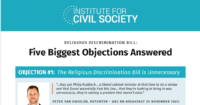The Institute for Civil Society has made a submission to the Victorian Parliament’s Scrutiny of Acts and Regulations Committee regarding the Andrews Government’s Voluntary Assisted Dying Bill. A PDF version can be accessed here.
Statement of Compatibility on the Voluntary Assisted Dying Bill 2017
12 October 2017
Ms Lizzie Blandthorn MP
Scrutiny of Acts and Regulations Committee
Parliament of Victoria
In light of the below considerations, we urge the Committee to find that the Voluntary Assisted Dying Bill 2017 is incompatible with the human rights set out in the Charter of Human Rights and Responsibilities, and also that it trespasses unduly upon the rights and freedoms of Victorians.
Summary
Contrary to the Minister’s Statement of Compatibility, we submit that:
- the Bill is not compatible with the right to life in section 9 of the Charter of Humans Rights for and Responsibilities Act 2006 (the Charter), either unconditionally or because the Bill does not provide sufficient safeguards to protect vulnerable people from death as required by international human rights law;
- the Statement of Compatibility provides an inadequate account of the international human rights law on the right to life;
- the Bill does not promote the right to protection from cruel, inhuman or degrading treatment in section 9 of the Charter;
- the Bill does not promote the right to privacy in section 13 of the Charter;
- the Bill does not promote the right to liberty and security of the person as interpreted by the majority of international human rights sources with the outlier exception of the Canadian Supreme Court’s decision in Carter v Canada;
- the Bill is not compatible with the human rights set out in the Charter and the Committee should report that to the Parliament.
I. Right to life (section 9)
Section 9 of the Charter states “Every person has the right to life and has the right not to be arbitrarily deprived of life.”
The Victorian Charter is based on the International Covenant on Civil and Political Rights (ICCPR). Section 9 of the Charter is based on Article 6 of the ICCPR. Article 6 (1) states that, “Every human being has the inherent right to life. This right shall be protected by law. No one shall be arbitrarily deprived of his life.”
The Statement of Compatibility (SOC) rightly states:
The right to life is said to be an inherent and ‘supreme’ right, without which all other human rights would be devoid of meaning…. The right in section 9 of the Charter includes an obligation on the government to refrain from conduct that results in the arbitrary deprivation of life, as well as a positive duty to introduce appropriate safeguards to minimise the risk of loss of life.”[i]
The Statement continues on page 6:
At international law, and in other countries including Canada, an assisted dying regime can be compatible with the right to life, provided that there are sufficient safeguards to prevent abuse of vulnerable people.[ii]
This latter statement is not substantiated in the Statement of Compatibility at all. It is not correct that an assisted suicide/euthanasia regime has been found to be compatible with the right to life “at international law.” See the discussion of the ICCPR and European Court of Human Rights interpretation of the right to life below.
Later on page 6 the Statement says:
“For the reasons set out below, I am satisfied that the Bill does not limit the right to life. I acknowledge that others may take the view that the Bill will limit the right to life in which case in my view it would do so in a demonstrably justifiable way.”
But the closest the Statement comes to “reasons set out below” is:
- an argument at pages 5-6 that the assisted suicide and euthanasia regime provided for in the Bill may promote the right to privacy in section 13 and the right to liberty and security in section 21; and
- the conclusory statement at page 6 that “In my opinion the very limited circumstances in which voluntary assisted dying may be accessed, the careful balance of rights struck by the Bill and the numerous safeguards mean that any limit to the right to life is demonstrably justified in a free and democratic society.”
Is an Assisted Suicide and Euthanasia Regime Consistent with the Right to Life in International Law?
A) International Covenant on Civil and Political Rights
The Victorian Charter is based on the International Covenant on Civil and Political Rights (ICCPR). The ICCPR Article 6 (1) states that “Every human being has the inherent right to life … No one shall be arbitrarily deprived of his life.” The UN Declaration of Human Rights, Article 3, states that “Everyone has the right to life, liberty, and security of person.”
The UN Human Rights Committee (UNHRC) is the principal authority on the interpretation of the ICCPR.
When the UNHRC made its 2001 human rights report on the Netherlands it commented as follows on the new Netherlands law on the Termination of Life on Request and Assisted Suicide (we have omitted comments on features of the Netherlands law not applicable to the Victorian Bill).
“(a) The Committee discussed the issue of euthanasia and assisted suicide. …The Committee is well aware that the new Act does not as such decriminalize euthanasia and assisted suicide. However, where a State party seeks to relax legal protection with respect to an act deliberately intended to put an end to human life, the Committee believes that the Covenant obliges it to apply the most rigorous scrutiny to determine whether the State party’s obligations to ensure the right to life are being complied with (articles 2 and 6 of the Covenant).
(b) The new Act contains, however, a number of conditions under which the physician is not punishable when he or she terminates the life of a person, inter alia at the “voluntary and well-considered request” of the patient in a situation of “unbearable suffering” offering “no prospect of improvement” and “no other reasonable solution”. The Committee is concerned lest such a system may fail to detect and prevent situations where undue pressure could lead to these criteria being circumvented. The Committee is also concerned that, with the passage of time, such a practice may lead to routinization and insensitivity to the strict application of the requirements in a way not anticipated. The Committee learnt with unease that under the present legal system more than 2,000 cases of euthanasia and assisted suicide (or a combination of both) were reported to the review committee in the year 2000 and that the review committee came to a negative assessment only in three cases. The large numbers involved raise doubts whether the present system is only being used in extreme cases in which all the substantive conditions are scrupulously maintained. …
(d) The Committee, having taken full note of the monitoring task of the review committee [NB: similar to the proposed Victorian Assisted Dying Review Board] is also concerned about the fact that it exercises only an ex post control, not being able to prevent the termination of life when the statutory conditions are not fulfilled. The State party should re-examine its law on euthanasia and assisted suicide in the light of these observations. It must ensure that the procedures employed offer adequate safeguards against abuse or misuse, including undue influence by third parties. The ex ante control mechanism should be strengthened.”[iii]
Eight years later in its report on the Netherlands in 2009, the UNHRC stated with reference to Article 6 of the ICCPR, that:
“The UNHRC remains concerned at the extent of euthanasia and assisted suicides in the State party. Under the law on the Termination of Life on Request and Assisted Suicide, although a second physician must give an opinion, a physician can terminate a patient’s life without any independent review by a judge or magistrate to guarantee that this decision was not the subject of undue influence or misapprehension.
The Committee reiterates its previous recommendations in this regard and urges that this legislation be reviewed in light of the Covenant’s recognition of the right to life.”[iv]
It is very surprising that the Statement of Compatibility has omitted to cite these opinions by the UNHRC, the principal international law interpreter of the ICCPR.
The UNHCR opinion is that euthanasia and assisted suicide are inconsistent with the Article 6 right to life, at least unless there are rigorous criteria and safeguard and systems such as review by a judge or magistrate, applied before death, not after death, to detect and prevent situations where undue pressure, influence pressure or misapprehension could lead to these criteria being circumvented.
The UNHRC’s comments on ICCPR Article 6 and its significant concerns that the parts of the Netherlands law comparable with the Bill were not compatible with the right to life is highly relevant for the interpretation of the Victorian Charter s 9 and the Parliament’s consideration of this Bill.
B)European Court of Human Rights (ECtHR) jurisprudence
Article 2 of the European Convention on Human Rights (ECHR) states: “No one shall be deprived of his life intentionally save in the execution of a sentence of a court following his conviction of a crime for which this penalty is provided by law.” The European Court of Human Rights (ECtHR) has found that Article 2 supports laws criminalising assisted suicide and euthanasia, laws which the Victorian Bill proposes to repeal. The Court has also found that Article 2 does not confer a “negative” right to life (i.e. a right to die early by assisted suicide or euthanasia).
The main ECtHR case which deals with the question of physician assisted suicide (PAS)/euthanasia in the context of the right to life is Perry v. the United Kingdom.[v] Mrs Perry, the applicant, was suffering was motor neurone disease (a degenerative and incurable disease) and wished to control how and when she would die. She was unable to commit suicide herself, and so wished her husband to assist her. The UK Director of Public Prosecutions would not grant her husband immunity if he assisted Mrs Pretty. The case was taken to the ECtHR on the basis (as the applicant argued) that the prohibition on assisting suicide in English law infringed Mrs Pretty’s rights, including her right to life under Article 2 of the ECHR.
The Court found that Article 2 of the Convention “safeguards the right to life, without which enjoyment of any of the other rights and freedoms in the Convention is rendered nugatory.”[vi] Further, the Court found that under the Article there is a clear “obligation [for] the State to protect life” and that “the Court is not persuaded that “the right to life” guaranteed in Article 2 can be interpreted as involving a negative aspect”.[vii] It is, according to the Court, “unconcerned with issues to do with the quality of living or what a person chooses to do with his or her life,” the clear implication being that the right to life is not itself to be subsumed into a right to self-determination with regard to one’s own life or death.[viii] Indeed, the Court went on to affirm this exact thing, stating:
“Article 2 cannot, without a distortion of language, be interpreted as conferring the diametrically opposite right, namely a right to die; nor can it create a right to self-determination in the sense of conferring on an individual the entitlement to choose death rather than life.”[ix]
Therefore, the Court found that there is no right to die conferred under Article 2 of the ECHR.[x]
In the common law of Australia, the distinction has always existed between the withdrawal of medical treatment (which may or may not lead to death) and an intentional medical intervention with the intention to bring about the end life by causes other than natural ones. This issue was dealt with by ECtHR in Lambert and Others v. France. The applicants were contesting a decision by a group of doctors to cease treating Vincent Lambert, who was in a vegetative state. The Court found that Article 2 was not contravened in this case. The case is not, strictly speaking, about an assisted suicide or euthanasia. We raise it, in part, to demonstrate a contrast in approach but also to demonstrate the similarities.
The Court carefully differentiated between ceasing medical treatment which sustained life and voluntary/physician assisted suicide:
“The aim of the medical decision was not to put an end to life, but to discontinue a form of treatment which had been refused by the patient or – where the patient was unable to express his or her wishes – which constituted, in the doctor’s view based on medical and non-medical factors, unreasonable obstinacy.”[xi]
The Court held that France had not contravened its “negative obligations” under Article 2 to refrain from the intentional taking of life.[xii] It also found that the “positive obligations” under Article 2 were not contravened, as “both the legislative framework laid down by domestic law, as interpreted by the Conseil d’État, and the decision-making process, which was conducted in meticulous fashion in the present case” were “compatible with the requirements of Article 2.”[xiii] The decision-making process included taking into account the express wishes of Mr Lambert.
The Court also noted that:
“The Conseil d’État established two important safeguards in that judgment. Firstly, it stated that “the sole fact that a person is in an irreversible state of unconsciousness or, a fortiori, has lost his or her autonomy irreversibly and is thus dependent on such a form of nutrition and hydration, does not by itself amount to a situation in which the continuation of treatment would appear unjustified on grounds of unreasonable obstinacy”. Secondly, it stressed that where a patient’s wishes were not known, they could not be assumed to consist in a refusal to be kept alive.”[xiv]
While the Court was silent as to whether any reversal of the above factors would have altered its decision, it is a reasonable implication that the fact that the decision of the doctors was “not to put an end to life” ruled out a contravention of Article 2 based simply on the doctor’s potential action to withdraw treatment. If the doctors had decided to administer a lethal drug it would have altered the complexion of the case considerably.
In summary, it is not correct that an assisted suicide or euthanasia regime—such as the one proposed in this Bill—is compatible with the “right to life” at international law, at least not without the rigorous safeguards and before the fact judicial and other controls noted by the UNHRC.
C) Other Jurisdictions
The Minister referenced Canada as a jurisdiction in which an assisted dying regime is understood to be consistent with the right to life. In Carter v Canada, the court ruled that:
“We do not agree that the existential formulation of the right to life requires an absolute prohibition on assistance in dying, or that individuals cannot “waive” their right to life. This would create a “duty to live”, rather than a “right to life”, and would call into question the legality of any consent to the withdrawal or refusal of lifesaving or life-sustaining treatment. The sanctity of life is one of our most fundamental societal values. Section 7 is rooted in a profound respect for the value of human life. But s. 7 also encompasses life, liberty and security of the person during the passage to death. It is for this reason that the sanctity of life “is no longer seen to require that all human life be preserved at all costs” (Rodriguez, at p. 595, per Sopinka J.). And it is for this reason that the law has come to recognize that, in certain circumstances, an individual’s choice about the end of her life is entitled to respect.”[xv]
However, it is notable that Canada is the sole Western (and perhaps only) jurisdiction to find that a system for assisted suicide is not only consistent with the inherent human right to life but required by human rights. Indeed, no jurisdiction other than Canada that we know of has found that laws against assisted suicide or euthanasia breach human rights. Insofar as the Statement of Compatibility cites Canada as an example of unspecified “other countries”, it creates a misleading impression.
Courts in other jurisdictions have held that there is no constitutional human right to die:
In Washington v Glucksberg,[xvi] the United States Supreme Court rejected an argument that a ban on physician assisted suicide was a violation of the Due Process Clause of the Fourteenth Amendment of the US Constitution (no person shall be deprived of life liberty or property without due process of law), as assisted suicide is not a fundamental liberty interest.[xvii]
Several US State’s highest Courts have come to the same view on human rights under State constitutions. In September 2017, the New York Court of Appeals, in the case of Myers v Schneiderman, rejected the Plaintiff’s argument that individuals have a constitutional right to assisted dying. The Court stated:
Although New York has long recognized a competent adult’s right to forgo life-saving medical care, we reject plaintiffs’ argument that an individual has a fundamental constitutional right to aid-in-dying as they define it.[xviii]
Judge Rivera pointed out in his concurring ruling that, across a number of cases, the Court had consistently held “that an individual has a fundamental right to refuse medical treatment but, implicitly, not to physician-assisted suicide,” and that the legislature’s criminalisation of assisted suicide is rationally related to the legitimate government interest of protecting life.[xix]
In 2015, the High Court of New Zealand ruled that it would not be lawful under the Crimes Act for a doctor to assist in the death of a terminally ill patient, and that the relevant provisions of that Act were consistent with the “Right not to be deprived of life” as stated in the New Zealand Bill of Rights.[xx] The Court stated that the applicant’s right to life was engaged in her circumstances of wishing to end her life due to her illness, but that “In the present context, the interference with Ms Seales’ right to life is based upon grounds established by law.”[xxi]
In late 2016, the South Africa’s Supreme Court of Appeal reversed a decision of the High Court that would have allowed physician assisted suicide.[xxii] Wallis JA stated that the Court was not the proper body to decide on the issue, and said:
“that the social and moral dimensions of the issue, its inherent difficulty, and the fact that there is much to be said on both sides make Parliament the proper organ to deciding it.”[xxiii]
Further, Wallis JA, in his criticism of a previous ruling by the High Court, stated that the question of PAS needed to be decided with consideration of:
“The impact of its decision beyond our affluent suburbs into our crowded townships, our informal settlements and in the vast rural areas that make up South Africa. It is in that context that it must determine whether its decision will further undercut the foundational value of the right to life or be supportive of it. The notion of a dignified death must be informed by a rounded view of society, not confined to a restricted section of it.”[xxiv]
The Court noted that there was significant variation in the understanding of the relationship between the constitutional right to life and PAS, and that “No constitutional instrument embodies a right to commit suicide or to determine the time and manner of one’s death or to have assistance in hastening the arrival of death.”[xxv] The Court ruled that it was not right for the Court to hold that the criminal law ought to be developed to accommodate PAS or euthanasia.[xxvi]
Very recently, on 5 October 2017, the UK High Court delivered its judgment in respect of an application on behalf of Mr Noel Conway, who has motor neurone disease, for a ruling that s 2 of the Suicide Act 1961, under which encouragement of or assistance with suicide is a criminal offence, constitutes a disproportionate interference with his right of respect for his private life under Article 8 of the ECHR and is therefore incompatible with that Article.[xxvii] The Court ruled that s 2 of the Suicide Act was compatible with Mr Conway’s rights under Article 8 and dismissed the application.[xxviii]
To reiterate, Canada is the only jurisdiction we are aware of where laws against assisted suicide and euthanasia have been held to constitute a breach of human rights and that constitutional human rights require the State to provide an assisted suicide/euthanasia regime.
II. Privacy (section 13)
There are suggestions in some European cases that the right to privacy in Article 8 of the European Convention of Human Rights makes a limited and closely safeguarded assisted suicide or euthanasia regime compatible with human rights. This is based on reading into the right to privacy a broad right to human autonomy which is a long stretch that Victorian courts have not made.
We submit that reading is not correct and certainly not for the wording of s.13 of the Charter.
Even if it were correct, we submit that this Bill is not attended with the necessary robust safeguards applied in advance of death to protect the vulnerable that would enable it to be compatible with the alleged right to autonomy said to be found in the privacy right and also the right to life.
Section 13 of the Victorian Charter states:
“A person has the right—
(a) not to have his or her privacy, family, home
or correspondence unlawfully or arbitrarily
interfered with; and
(b) not to have his or her reputation unlawfully
attacked.”
The Statement of Compatibility claims that “by allowing Victorians who are suffering at the end of their life, in very limited circumstances, to choose to end their life according to their own preferences,” the VAD Bill promotes the right to privacy.[xxix]
The actual words of s 13 have no direct application to VAD, as contemplated by the VAD Bill, since the VAD regime involves no unlawful or arbitrary interference with a person’s privacy. If the process operates exactly as the Bill intends, the initial and subsequent requests for VAD will emanate from the person concerned, the person will make their own call as to whether or not their suffering can be relieved in a manner acceptable to them and the person will personally administer the drugs if and when they decide to do so. Accordingly, the Bill does not sanction any unlawful or arbitrary interference with a person’s privacy, whether by the State, the medical profession or by those who stand to gain from the person’s death.
However, the Statement of Compatibility seizes on the fundamental values underlying the right to privacy under s 13 – one being the autonomy and inherent dignity of the person – and maintains that the Bill promotes the right to privacy by maximising the autonomy and dignity of a dying person by permitting them to choose the time and manner of their death. In so doing, the Statement of Compatibility appears to interpret s 13 as conferring not just a freedom to commit suicide (which has been the case since the abolition of suicide as a crime) but as going some way towards promoting a right to suicide as an exercise of one’s autonomy. In so doing, the Statement of Compatibility appears to be following the lead of the European Court of Human Rights (ECtHR) in its interpretation of Article 8 of the European Convention on Human Rights (ECHR).[xxx]
We would argue that such an interpretation of the values of dignity and autonomy (which underpin s 13) should be avoided. First, whereas Article 8 demands respect for private and family life, s 13 of the Charter is expressed in more negative terms as a right not to have one’s privacy unlawfully or arbitrarily interfered with.[xxxi] It should not be interpreted as a positive right.
Second, Grégor Puppinck and Claire de La Hougue have identified some serious implications of appealing to the right to autonomy and dignity in this context.[xxxii] These scholars have discerned and traced a shift in the ECtHR’s interpretation of the ECHR in the context of voluntary assisted dying from a strict interpretation and protection of the right to life and the sanctity of life under Article 2 (which, as explained above, cannot accommodate euthanasia or VAD) to the recognition of a right to a certain quality of life (held to be implicit in Article 8). That is, Puppinck and de La Hougue explain that the ECtHR has interpreted Article 8 in such a way that the quality of life “prevails over life itself.”[xxxiii] In so doing, the authors regard the Court as having acted “from an individualistic conception of dignity, which implies a right to a quality of life, in particular against old age and decay,”[xxxiv] thereby effecting a “reversal between life and freedom in the hierarchy of values.”[xxxv] They conclude that:
“In substituting the ‘inherent dignity’ for a relative dignity, measured by the individual’s feeling, the court radically modifies the ontological foundation of the Convention, that of being universal to a particular. The court removes from rights their objectivity by rendering them subjective, and therefore relative to their subject. In doing so, the measure of human rights is no longer the human, but each individual.”[xxxvi]
Yet:
“In reality, the intrinsic authority of human rights is an expression of their universality. Without universality, there is no authority.”[xxxvii]
In so far as the Statement of Compatibility claims that the VAD Bill promotes the values that underpin s 13 (human autonomy and dignity), it runs the risk of suggesting that the section creates a right to die. This has the potential to lead to similar consequences as those identified by Puppinck and de La Hougue. One is that the courts’ interpretation of s 13 may override s 9. As explained above, this has arguably occurred in Europe, leading to an emphasis on the subjective assessment of quality of life (protected by Article 8) over an objective right to life (protected by Article 2). Ironically, this leads to the conclusion that not all human life has inherent dignity.
It may also entail the consequence that the state has an obligation to place the means of committing suicide at the person’s disposal, thereby increasing a person’s dependence on the State, rather than securing their freedom from its power.[xxxviii] This would seem to be detrimental to their personal autonomy.
Finally, if autonomy is the key criterion, it renders the eligibility criteria enshrined in the Bill susceptible to challenge on the basis that the State has no right to restrict the exercise of the right to die to terminally ill people whose death is likely to occur within a particular time frame and whose current circumstances are characterised by unrelievable suffering.
III. Inadequate safeguards in this Bill render it incompatible with human rights even on the Statement of Compatibility arguments from a supposed right of autonomy in the privacy right
The Bill has a number of safeguards. We will address some key weaknesses in these to further demonstrate that it is incompatible with human rights.
A) Voluntariness
The Bill’s “Voluntariness” test is a paper safeguard and provides less protections than giving a guarantee. The euphemism “voluntary assisted dying” is used over 300 times in the Bill. But the only relevant safeguard in the Bill is that the two doctors involved are satisfied that the person making the request is “acting voluntarily and without coercion”. The Bill is completely silent on how doctors are meant to do that. Presumably the doctors can simply rely on the person’s statement in their written request that they are acting voluntarily.
Doctors are protected from all legal and professional liability if they comply with the Act’s procedures in good faith and without negligence, so there is little or no legal liability incentive for practitioners to go behind a requester’s statement that they are acting voluntarily. Hints of family or carer pressure can be left uninvestigated.
But we know from reports by the Royal Commission into Family Violence (2016), the Australian Law Reform Commission (2017) and Victoria’s State Trustees (2017), that abuse of the elderly, often by a family member, is increasingly common.[xxxix] The Royal Commission into Family Violence report shows that family violence against older people tends to be under-reported, and can be physical, psychological, emotional or sexual, and the majority of victims are women. State Trustees research is that 5% of Victorians over 65 have reported financial elder abuse (actual incidence is likely higher) and this manifests as misappropriation of funds and assets, or changes to a will, either fraudulently or through undue influence. While this Bill does not require doctors to actively consider elder abuse, the ALRC Report recommended a new statutory duty on agencies to make inquiries where they have reasonable grounds to suspect that a person is at risk of abuse or neglect and is unable to protect themselves from abuse or neglect because of their care and support needs.
The Bill seems oblivious to many rules of law designed to protect a person from the undue influence, misrepresentation or unconscionable conduct of another person. Before a bank accepts a parent’s guarantee of a loan to a son or daughter, the bank is required by law to provide warning notices and fact sheets in prescribed form to the guarantor. Most banks require parents who go guarantor to take independent legal or financial advice before signing to reduce the risk that they are being manipulated or pressured by their children. Nothing like independent advice is required under this Bill for a much more significant decision than giving a guarantee. Guarantees can be set aside by a court if they were obtained by undue influence or unconscionable conduct or misrepresentation. A suicide obtained by those means can’t be set aside. It seems that a decision to request assisted suicide will be subject to less legal scrutiny and protection than a decision to give a family guarantee.
B) Focus on Decision making capacity ignores soundness of judgment
By focussing mainly on decision making capacity of the person, the Bill ignores the effects of significant depression and mood disorders on a person’s ability to make sound judgments in their best interest. We would not think that it is acceptable for a depressed 25 year old to take a poison to kill themselves just because they had decision making capacity and understood the effects of taking the poison. We would ask how their judgment was affected by the depression and how that depression could be addressed. Just because a doctor predicts that the person has 12 months to live, should we no longer care about the person’s depression or soundness of judgment? The Bill should require that the person making the request must not have impaired judgment due to depression or mood disorders or other psychiatric conditions and require a separate qualified psychiatric assessment to ensure that is the case
C) No safeguards at all at the time of ingesting the drugs
There are other issues with the eligibility criteria but the most glaring one is that in the usual case where the drugs are to be self-administered by the person there are no checks or safeguards at the time the drugs are taken. No doctor or third party needs to be present. No-one checks at the time the drugs are taken whether the person has decision making capacity or is seriously depressed or is acting voluntarily and without family or carer pressure or even whether the person administers the drugs themselves or someone else forces administration.
The above only addresses some of the concerns that we have with the safeguards as laid out in the Bill. As it currently stands, we maintain that the Bill’s safeguards are not strong enough to make it compatible with human rights.
Conclusion
In light of the above considerations, we would urge the Committee to find that the Voluntary Assisted Dying Bill 2017 is incompatible with the human rights set out in the Charter of Human Rights and Responsibilities, and also that it trespasses unduly upon the rights and freedoms of Victorians.
Mark Sneddon
Executive Director, Institute for Civil Society
Adjunct professor of Law Monash University
Dr Sharon Rodrick
Research Analyst, Institute for Civil Society
Senior Lecturer in Law Monash University
Simon Kennedy
Research Analyst, Institute for Civil Society
(Note: Opinions are not offered on behalf of Monash University)
[i] Voluntary Assisted Dying Bill 2017 (Vic), Statement of Compatibility: Charter of Human Rights and Responsibilities Act 2006, 2.
[ii] ‘Statement of Compatibility’, 3.
[iii] UN Human Rights Committee (HRC), UN Human Rights Committee: Concluding Observations: Netherlands, 27 August 2001, CCPR/CO/72/NET, available at: http://www.refworld.org/docid/3be1202a4.html [accessed 12 October 2017].
[iv] UN Human Rights Committee (HRC), Concluding observations of the Human Rights Committee: Netherlands, 25 August 2009, CCPR/C/NLD/CO/4, available at: http://www.refworld.org/docid/4aa7aa642.html [accessed 9 October 2017], paragraph 7.
[v] Perry vs. the United Kingdom (2346/02, 29 July 2002)
[vi] Perry vs. the United Kingdom, para 37.
[vii] Ibid., para 39.
[viii] Ibid., para 39.
[ix] Ibid., para 39.
[x] Ibid, para 40 and 42.
[xi] Ibid., para 120.
[xii] Ibid., para 124.
[xiii] Ibid., para 181.
[xiv] Ibid., para 159.
[xv] Carter v. Canada (Attorney General), 2015 SCC 5, [2015] 1 S.C.R. 331, para 63.
[xvi] 521 US 702 (1997).
[xvii] This does not prevent the States from legalising assisted suicide and indeed a number of State Parliaments have done so.
[xviii] Myers v Schneiderman 2017 NY Slip Op 06412 Decided on September 7, 2017.
[xix] Ibid., J. Rivera, concurring ruling, sec II.
[xx] Seales v Attorney-General [2015] NZHC 1239 (4 June 2015), para 12.
[xxi] Ibid., para 168.
[xxii] Minister of Justice and Correctional Services and Others v Estate Late James Stransham-Ford and Others (531/2015) [2016] ZASCA 197; [2017] 1 All SA 354 (SCA) (6 December 2016).
[xxiii] Ibid, para 102.
[xxiv] Ibid, para 100.
[xxv] Ibid, para 62.
[xxvi] Ibid, para 101.
[xxvii] http://www.livinganddyingwell.org.uk/publications/our-reports/high-court-judgment-in-the-case-of-mr-noel-conway
[xxviii] Conway, R On the Application of v The Secretary of State for Justice (Rev 1) [2017] EWHC 2447 (Admin).
[xxix] ‘Statement of Compatibility’, 3.
[xxx] See Pretty v. the United Kingdom (n° 2346/02, 29th April 2002), Haas v. Switzerland (no 31322/07, 20th January 2011); Koch v. Germany (no 497/09, 19th July 2012).
[xxxi] Of course it is possible to argue that in so far as the State of Victoria makes no provision for voluntary assisted suicide its failure to do so constitutes an arbitrary interference with the privacy of its citizens. However, this seems to rest on there being a right to die, which in turn depends on one’s interpretation of what a person’s autonomy and dignity demand.
[xxxii] Puppinck and de La Hougue, “The right to assisted suicide in the case law of the European Court of Human Rights,” 735.
[xxxiii] Ibid, 746.
[xxxiv] Ibid.
[xxxv] Ibid.
[xxxvi] Ibid., 747.
[xxxvii] Ibid.
[xxxviii] Ibid, 750.
[xxxix] See https://www.alrc.gov.au/publications/elder-abuse-report (Recommendation 14) https://www.statetrustees.com.au/state-trustees-supports-recommendations-financial-elder-abuse-royal-commission-family-violence/ http://www.rcfv.com.au/MediaLibraries/RCFamilyViolence/Reports/Final/RCFV-Summary.pdf pp 33-34








Recent Comments